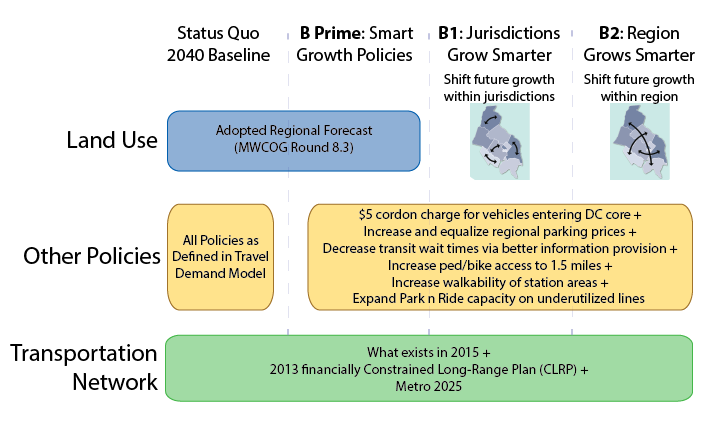Would a Cordon Charge Help Stabilize Metro’s Finances? (Part 4)
Adding a London-style cordon charge (or fee) to enter much of the region’s central employment area would increase transit ridership across all modes and also reduce (or eliminate) the subsidy that local governments pay every year to support Metro, meaning lower tax bills for regional residents.*
(This post is part of a multi-part series about ConnectGreaterWashington (CGW) a study that WMATA completed in 2015 and its application of land use and pricing as a transportation strategy.)

Scenario “B” looked at land use shifts and increasing the price of driving, and how those changes would impact Metro.
Metro asked, “What if the region’s future growth was used to fulfill the expectations of regional plans such as Region Forward and Place + Opportunity? What if transit-supportive policies were implemented across the region? Would WMATA benefit? Would the region?”
Answer: YES!!
*Note that Metro is not proposing that the region adopt a cordon charge, but it was tested as part of an analysis of how smarter land use and more transit-supportive policies could impact transit ridership, our operating subsidy, and other measures that support the region’s growth.
Approach: Metro planners hypothesized that changing local jurisdictions’ and/or the region’s approach to development, such as where to guide future jobs and population, and implementing more transit-supportive policies, such as reducing transit wait times, improving walk and bike access, and increasing the cost of driving for some trips could enable the region to better use the transportation system we already have rather than require us to spend tens of billions on new transportation projects.
Planners developed three different scenarios (A, B, and C) to test their hypothesis. In each scenario, the transportation system remained as is, but the future land use forecasts and locations and policies that could affect demand varied. The below post talks only about Scenario B, which had a specific goal of reducing the subsidy that the jurisdictions pay annually to support Metrorail operations. The image above shows how we built Scenario B and its three iterations (B Prime, B1, B2).
The benefits of both supercharging existing transit markets AND making it less desirable to drive between them resulted in some pretty amazing results, especially in terms of ridership across all transit modes.
- Scenario B Prime: Disincentivizing driving on trips where transit is viable WORKS WONDERS to change the trajectory of transit ridership, roadway congestion, and Metrorail’s operating subsidy without ever having to talk about land use and future development decisions. This is a huge piece of useful information if discussing land use and development growth becomes too intractable.
- Scenario B1: Making it less desirable to drive between existing travel markets while also growing smarter within each jurisdiction increased all transit ridership and reduced traffic congestion in the region, which reduced the Metrorail operating subsidy to under $100 million, but also increased the level of crowding across all transit modes, especially Metrorail.
- Scenario B2: Making it less desirable to drive between existing travel markets while also growing smarter as a region increased ridership so dramatically that Metrorail had a massive operating surplus. However, the ridership and crowded conditions that resulted from this scenario are not feasible given the current transit infrastructure and carrying capacity, so significant expansion would be needed to make this scenario a reality.
- The transit-supportive policies selected in this scenario created an environment where the cost of driving outweighed the time it takes to drive, which shifted people to transit.
If you’d like to geek out, you can peruse a more detailed description of Scenario B, its iterations, inputs, results and key findings. (pdf)
Should the region consider a cordon charge to reduce driving and increase revenues for transit? Where would you draw the boundary?
ConnectGreaterWashington Land Use Assessment: Summary of Blog Posts
Part One of the series discussed why local land use decisions matter so much to Metro and summarized the potential benefits of approaching growth from a regional perspective. Part Two outlined the study’s goals, assumptions, and approach to developing scenarios to assess benefits. Part Three shows the outcomes from modeling scenarios (Scenario A) that sought to increase system utilization and better balance the use of Metrorail across the system. Part Four shows the outcomes from modeling scenarios (Scenario B) that sought to reduce or eliminate Metrorail’s operating subsidy.


Highly unlikely that the U.S. Congress would permit a cordon charge.
@Mr. Transit
Fair criticism, Steve. We’re not recommending this, mind you, but in the spirit of the regional dialogue about funding Metro, are putting all of the ideas on the table. I have heard anecdotally from the DC Office of Planning that tolling bridges is actually within the permissible authority of DC Gov’t, so this concept might not require as much Congressional action as previously thought.